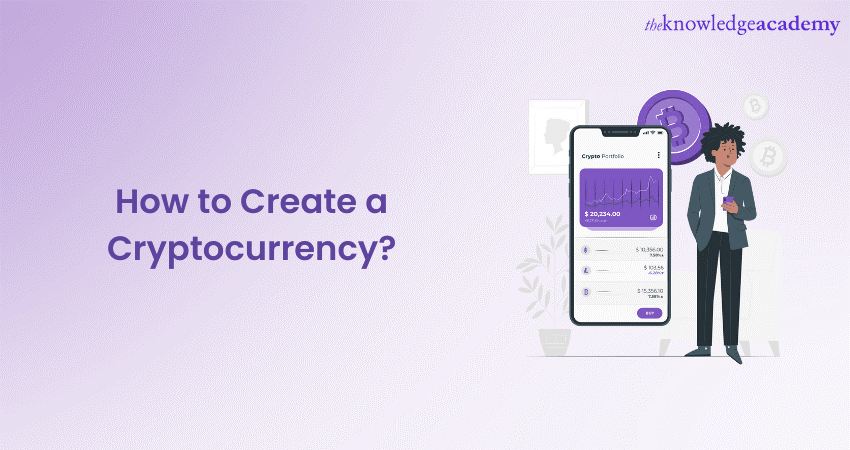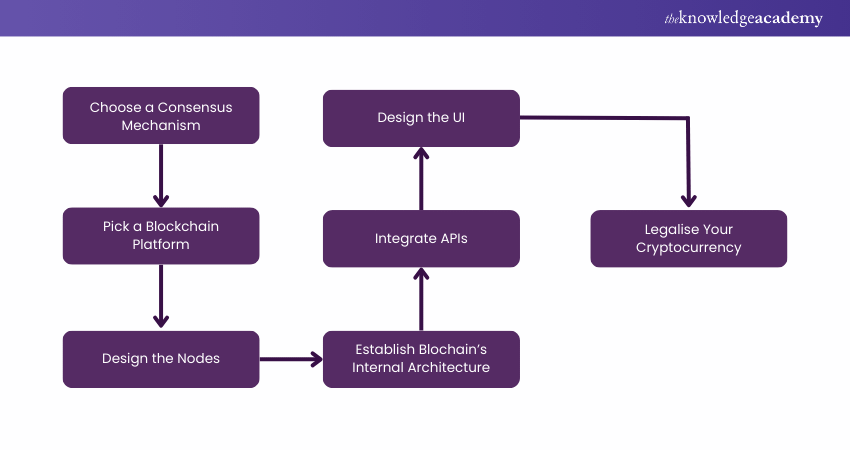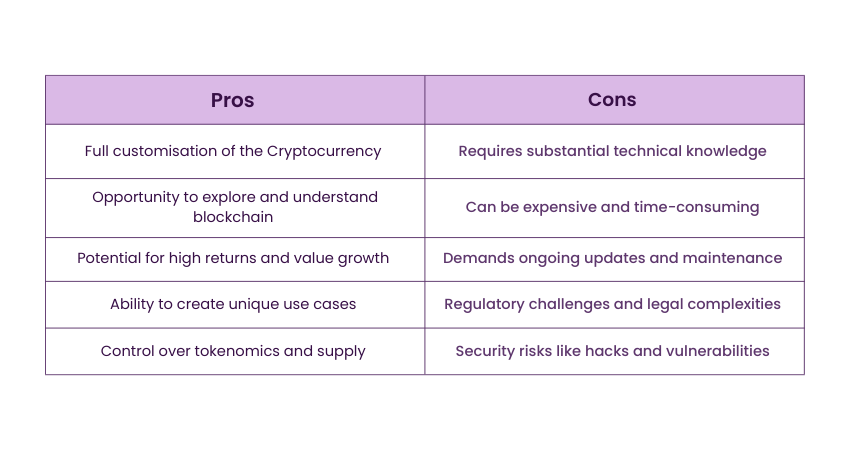We may not have the course you’re looking for. If you enquire or give us a call on + 1-866 272 8822 and speak to our training experts, we may still be able to help with your training requirements.
Training Outcomes Within Your Budget!
We ensure quality, budget-alignment, and timely delivery by our expert instructors.

It's no news that Cryptocurrencies such as Bitcoin and Ether have taken the financial landscape by storm. Ever wondered how these decentralised payment systems came into existence?The exciting part is, you don’t need to be a tech genius or have government approval to create your own cryptocurrency. With a bit of curiosity, some basic technical skills, and a clear roadmap, you can bring your coin concept to life.
This blog on How to Create a Cryptocurrency will guide you through the essential steps, from choosing a blockchain platform and designing APIs to recruiting miners. Dive in and start your thrilling journey to create your very own cryptocurrency!
Table of Contents
1) A Brief Overview of the Basics of Cryptocurrency
2) How to Create a Cryptocurrency?
3) How Cryptocurrency Works?
4) Pros and Cons of Making a Cryptocurrency
5) How Much Does it Cost to Make a Cryptocurrency?
6) Conclusion
A Brief Overview of the Basics of Cryptocurrency
Before you learn How to Create a Cryptocurrency, there are some basics of Cryptocurrency that you must be aware of. It represents a digital asset designed to function as a medium of exchange. It derives its name from the cryptographic techniques used to secure transactions, control the creation of new units, and verify asset transfers.
Cryptocurrencies leverage decentralised control as opposed to the centralised digital currency systems operating independently of a central bank. At the heart of it lies Blockchain Technology—a distributed ledger enforced by diverse computer networks. Bitcoin, the first Cryptocurrency, which paved the way for numerous other Crypto assets. As the Crypto domain progresses, understanding its foundational principles becomes imperative.

How to Create a Cryptocurrency?
Now, in this section, you will be learning how to create your own Cryptocurrency. Let’s begin:

Step 1: Define the Purpose
Developers use the Cryptocurrencies in a different way before they launch them in the digital currency markets. There are several purposes for Cryptocurrencies. These are:
a) Transferring money
b) Having alternate storage of wealth
c) Verifying data
d) Having smart Asset Management
Step 2: Choose a Consensus Mechanism
Consensus mechanisms determine how participants agree on the validity of transactions. Whether it's Proof of Work (PoW), Proof of Stake (PoS), or Delegated Proof of Stake (DPos), this choice is foundational. Let’s explore them further:
1) Proof of Work (PoW):
a) The first consensus mechanism was introduced by Bitcoin.
b) Miners solve cryptographic puzzles to validate transactions.
c) Energy-intensive and criticised for environmental impact.
2) Proof of Stake (PoS):
a) Validators are chosen based on the number of coins they hold. They are also willing to "stake" or lock up as collateral.
b) More energy efficient than PoW.
3) Delegated Proof of Stake (DPoS):
a) A democratic version where coin holders vote for a few nodes to conduct the validating
b) Faster transaction times but can be less decentralised.
Master the essential skills of trading through Cryptocurrency in our Cryptocurrency Trading Course – Sign up now!
Step 3: Selecting a Blockchain Platform
All Cryptocurrencies can operate from a Blockchain platform. These platforms allow transactions to take place every day with enhanced security measures. There are two options available for you:
a) Use the source code of an open-source blockchain platform as a basis for your own blockchain
b) Use already existing blockchains
c) These platforms differ from each other according to the consensus mechanismwhich determines if a Blockchain platform will consider the different types of transactions or not.
Step 4: Design Nodes
Nodes are internet-connected devices that form the infrastructure of a Cryptocurrency. Before the nodes are set up, four key considerations need to be kept in mind:
a) Will the nodes be public or private?
b) Will you have them on-site or in the cloud?
c) How many nodes will be needed?
d) Which operating system are they going to run?
There are two types of nodes:
a) Full Nodes: These store the entire Blockchain ledger and validate all transactions.
b) Light Nodes (or SPV Nodes): Store only a part of the ledger and rely on full nodes for transaction validations.
Step 5: Establish Blockchain's Internal Architecture
This step involves building the internal architecture. Aside from the technical aspect, some critical decisions regarding the economy and accessibility of your currency must be made, including:
a) Defining who can access, create, and validate new blocks.
b) Creating rules for asset issuance.
c) Building a management system for private storage and key protection.
d) Deciding the number of digital signatures your blockchain will require to verify the transactions.
e) Estimating the block size, block reward, transaction limits, etc.
f) Estimating how many coins you will offer.
Step 6: Desigining APIs and User Interface (UI)
Application Programming Interfaces (APIs) are vital for ensuring various functionalities in your Cryptocurrency platform. Integrating the right set of APIs is vital for the smooth and efficient operation of your Cryptocurrency, from transaction processing to security enhancements.
Depending on the complexity of your Blockchain, you may require a web, mail, FTP services, and external databases. This involves:
1) Wallet APIs: Enable the generation, storage, and management of private keys and transactions.
2) Data Storage and Retrieval: Facilitate interaction between your Blockchain and external databases.
3) Payment Gateways: Allow for Cryptocurrency transactions within online stores and platforms.
4) Pricing APIs: Fetch real-time or historical Cryptocurrency prices.
5) Smart Contract Interaction: Facilitate the deployment, execution, and management of smart contracts.
6) Chaincode/API for Custom Features: For unique functionalities not available with standard APIs.
7) Security: Implement APIs that offer enhanced security layers, like two-factor authentication.
8) Interoperability: APIs that allow communication with other Blockchains or systems.
9) Consider Third-party Providers: Many platforms offer pre-built APIs that can be integrated if you're not developing in-house.
Step 7: Design the Interface
A user-friendly interface is crucial. Through the user interface (UI) users interact with your Cryptocurrency, making its design paramount. Consider the wallet, admin panel, and user dashboard as you design. Here’s how:
1) User Experience (UX): Prioritise intuitiveness and user-friendliness to encourage adoption.
2) Wallet Interface: Allows you users to view balances, conduct transactions, and manage their cryptographic keys.
3) Admin Console: A backend system for monitoring and managing network activity.
4) Platform Dashboard: Offer a comprehensive view of transaction histories, network activity, and other pertinent data.
Master the mechanics of Bitcoin and Bitcoin mining in our comprehensive Bitcoin and Cryptocurrency Course - register now!
Step 8: Get Miners On board
Finally, to initiate the Cryptocurrency's activity, you need miners. They will validate and add transactions to the Blockchain. Here’s how you can bring miners on board:
1) Incentivisation: Offer rewards for successful block mining to encourage participation.
2) Fair Distribution: Ensure a transparent and equitable reward mechanism.
3) Mining Pools: Encourage the formation of mining pools to distribute computational tasks among multiple participants.
4) Educate: Offer resources and tutorials for beginners to get started.
5) Optimised Algorithms: Use mining algorithms that balance efficiency and energy consumption.
6) Hardware Considerations: Be inclusive of both ASICs and consumer-grade hardware for mining.
7) Community Building: Promote a community for miners to discuss, collaborate, and troubleshoot.
8) Transparent Communication: Maintain open channels for updates, changes, or network needs.
9) Safety Measures: Implement protections against centralisation, ensuring no single miner or pool gains dominance.
How Cryptocurrency Works?
Cryptocurrency is a kind of digital currency that leverages Cryptography for security. Here is a basic overview of how Cryptocurrency works:

a) Cryptocurrencies operate on a technology called Blockchain which manages and records transactions. This technology maintains the integrity and order of transactions which makes this digital currency decentralised and secure.
b) Cryptocurrencies are created through a process called mining. It involves solving complex mathematical problems which in turn generate coins. There are brokers from whom the users can purchase the currencies and then store them to spend later. These currencies are stored in Cryptographic wallets.
c) After the currencies are generated, transaction takes place. These transactions are recorded in a public ledger. To maintain security, transactions need a two-factor authentication process.
d) These Cryptocurrencies are decentralised and are not managed by any governing bodies. It is controlled by decentralised network of computers or nodes.
e) Anonymity is maintained, since the value of the Cryptocurrencies are highly volatile. There are several factors which influence this value, such as market sentiment, supply and demand, technological advancements, secure and transparent voting system, etc.
Pros and Cons of Making a Cryptocurrency
This table summarises the pros and cons of making a Cryptocurrency:

How Much Does it Cost to Make a Cryptocurrency?
The cost of creating a Cryptocurrency depends on how much you choose to customise the token or coin. Highly customised coins established on native blockchains are highly expensive to create, while launching a standardised token on the Ethereum platform can cost nothing through various apps.
Conclusion
In conclusion, learning How to Create a Cryptocurrency involves being well-versed with not just the important steps but the pros and cons too. While you don't need to be a tech pro or get government approval to create one, there can be security risks and legal complexities to deal with. Understanding the steps outlined in this blog will you navigate this ambitious and rewarding journey to scripting your own Crypto success story.
Navigate the world of trading and investment with ease by registering for our Investment and Trading Training!
Frequently Asked Questions

Cryptocurrencies these days are being considered legal tender in most countries. This includes trading them for products and services, mining, and other associated operations. However, it hasn’t been adopted in its entirety, countries like China still consider transactions in Cryptocurrencies an illegal affair.

You can create a cryptocurrency without extensive programming knowledge; however, you need a fair bit of knowledge to navigate this domain because you might face some limitations as it relies heavily on existing platforms and tools.

The Knowledge Academy takes global learning to new heights, offering over 30,000 online courses across 490+ locations in 220 countries. This expansive reach ensures accessibility and convenience for learners worldwide.
Alongside our diverse Online Course Catalogue, encompassing 17 major categories, we go the extra mile by providing a plethora of free educational Online Resources like News updates, Blogs, videos, webinars, and interview questions. Tailoring learning experiences further, professionals can maximise value with customisable Course Bundles of TKA.

The Knowledge Academy offers various Investment and Trading Training, including Cryptocurrency Trading Training, Investment Management Masterclass, and Day Trading Course. These courses cater to different skill levels, providing comprehensive insights into Investment methodologies.
Our Investment and Trading blogs cover a range of topics related to Investment, offering valuable resources, best practices, and industry insights. Whether you are a beginner or looking to advance your Trading skills, The Knowledge Academy's diverse courses and informative blogs have you covered.

The Knowledge Academy’s Knowledge Pass, a prepaid voucher, adds another layer of flexibility, allowing course bookings over a 12-month period. Join us on a journey where education knows no bounds.
Upcoming Advanced Technology Resources Batches & Dates
Date
 Cryptocurrency Trading Training
Cryptocurrency Trading Training
Fri 17th Jan 2025
Fri 21st Feb 2025
Fri 4th Apr 2025
Fri 6th Jun 2025
Fri 29th Aug 2025
Fri 24th Oct 2025
Fri 26th Dec 2025







 Top Rated Course
Top Rated Course


 If you wish to make any changes to your course, please
If you wish to make any changes to your course, please


